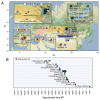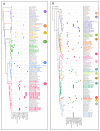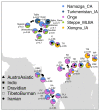The first horse herders and the impact of early Bronze Age steppe expansions into Asia
- PMID: 29743352
- PMCID: PMC6748862
- DOI: 10.1126/science.aar7711
The first horse herders and the impact of early Bronze Age steppe expansions into Asia
Abstract
The Yamnaya expansions from the western steppe into Europe and Asia during the Early Bronze Age (~3000 BCE) are believed to have brought with them Indo-European languages and possibly horse husbandry. We analyzed 74 ancient whole-genome sequences from across Inner Asia and Anatolia and show that the Botai people associated with the earliest horse husbandry derived from a hunter-gatherer population deeply diverged from the Yamnaya. Our results also suggest distinct migrations bringing West Eurasian ancestry into South Asia before and after, but not at the time of, Yamnaya culture. We find no evidence of steppe ancestry in Bronze Age Anatolia from when Indo-European languages are attested there. Thus, in contrast to Europe, Early Bronze Age Yamnaya-related migrations had limited direct genetic impact in Asia.
Copyright © 2018 The Authors, some rights reserved; exclusive licensee American Association for the Advancement of Science. No claim to original U.S. Government Works.
Conflict of interest statement
Figures







References
-
- Allentoft ME, Sikora M, Sjögren K-G, Rasmussen S, Rasmussen M, Stenderup J, Damgaard PB, Schroeder H, Ahlström T, Vinner L, Malaspinas AS, et al. Population genomics of bronze age Eurasia. Nature. 2015;522:167–172. - PubMed
-
- Damgaard PB, Marchi N, Rasmussen S, Peyrot M, Renaud G, Korneliussen Th, Moreno-Mayar JV, Pedersen MW, Goldberg A, Usmanova E, Baimukhanov N, et al. 137 ancient human genomes from across the Eurasian steppe. Nature. (accepted) - PubMed
-
- Anthony DW. The horse, the wheel, and language: how Bronze-Age riders from the Eurasian steppes shaped the modern world. Princeton University Press; 2010.
-
- Outram AK. In: The Oxford Handbook of the Archaeology and Anthropology of Hunter-Gatherers. Cummings V, Jordan P, Zvelebil M, editors. Oxford University Press; Oxford: 2014. pp. 749–766.
Publication types
MeSH terms
Substances
Grants and funding
LinkOut - more resources
Full Text Sources
Other Literature Sources
Research Materials

